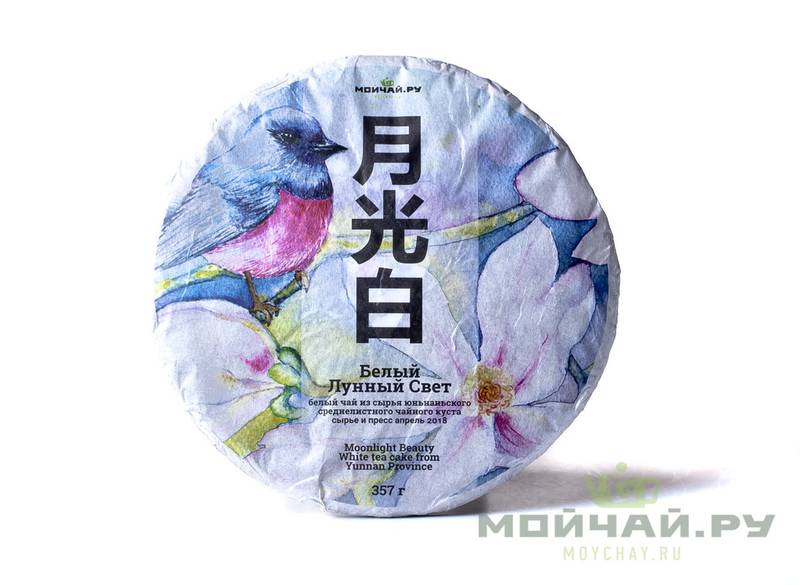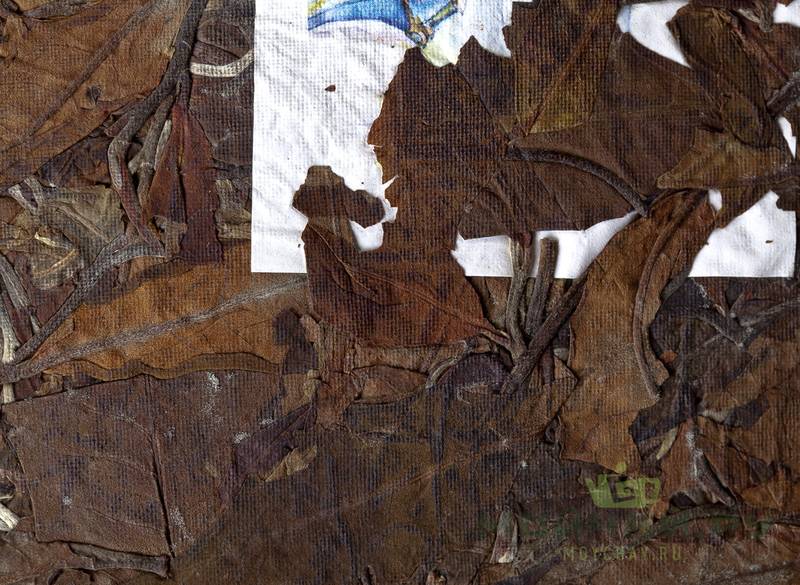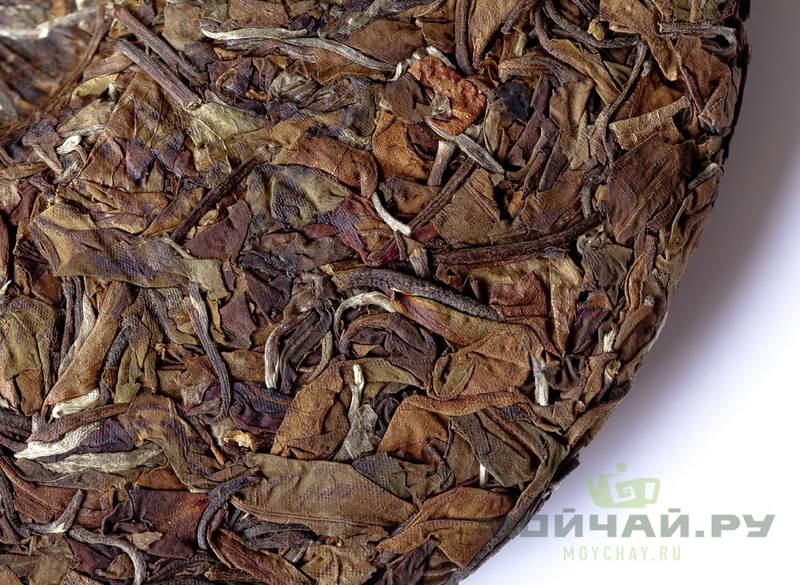To start, what is it? The page title lists: Yue Guang Bai (White moonlight, white Puer, Moychay.com), spring 2018 It’s currently sold out, but a similar product might replace it at some point.


It looks just like a shou mei cake, the most commonly pressed white tea, but “moonlight” is a reference to a completely different style of white tea from Yunnan. Per my understanding it’s only made from Assamica plant types (described for this version as “made from Yunnan Zhong Ye cultivar”), where other Fuding white teas are made from variety Sinensis plant types (Camelia Sinensis var. Sinensis). Beauty could be a reference to Oriental Beauty, or Bai Hao (also call Dong Fang Mei Ren; a tea with many names), the bug-bitten more-oxidized type of Taiwanese oolongs.
It’s probably closer to moonlight white, although those are typically partly silver to white with a darker color mixed on the one side. To me a perfect match to a standard type isn’t as important as the tea being good. The real tea character is revealed in trying it; brewing it, then brewing it again using different parameters.
I’ll be brewing the tea Gongfu style this time, which seems a natural fit, using enough tea to fill a gaiwan two thirds to three quarters full after soaking it. It is possible to judge that amount by the look of the dry tea but for people new to how different teas look compressed or loose (and rolled or twisted in different styles) it might work better to weigh it. I’ll brew it at a temperature around 90 C, only for a 15 second or so infusion time so far.
Varying the proportion can shift experienced aspects more than one might expect, even with infusion time adjustment balancing that back out. It’s normal for experienced tea drinkers to cite their own version of optimums, which don’t necessarily match those of other tea drinkers, but with a brand new style of tea like this one (a white that seems in between other versions in character) it’s hard to imagine anyone would go in with a clearly established preference. Expectations play a large role in drinking tea; whatever parameter set someone was convinced would work well might go better due to those being positive.
I had intended to go with a rinse, which is optional for white teas, and quite conventional for shou or aged sheng, or even rolled-style oolongs. The rinse step is to get the tea started infusing, to wet the leaves, and also to rinse off any material that it would be as well not to drink, to clean the tea. For fermented teas (shu pu’er, aged sheng pu’er, and other hei cha) trace amounts of toxins are one by-product of the fermentation process, so a rinse can reduce overall consumption levels of those, without costing much in the way of lost brewed tea potential.
The toxins probably aren’t at levels that require much concern but testing does identify they’re there, so it’s probably as well to go with the convention and rinse them. Unlike with caffeine, and various polyphenols, the fermentation activity of the micro-organisms responsible for fermentation (bacteria and fungus) are concentrated on the outer parts of the leaf, so there’s at least a chance that a higher proportion would be caught and removed in a rinse. Probably not, but it’s nice to think of it that way.
I drank some of the rinse after tasting it because it was really pleasant, strong flavored for being a flash infusion of dry leaves. The tea has an unusual savory quality; it’s towards flavor range that doesn’t often come up in tea, a bit towards the umami of chicken soup. With the right other aspects and sweetness level that can be much more pleasant than it sounds. The earliest indications from the rinse are that it will be a pleasant input for this tea, striking a great overall balance, and it seems likely enough that it will fall into a lower proportion later.
As expected spice ramps up on the first real infusion, with some degree of savory quality / umami aspect remaining but with the tea dropping into a more familiar range for aspects set. Cinnamon is part of that, per my interpretation, along with a warm sweetness matching dry freshly fallen autumn leaves. There’s a hint that fruit will emerge as the tea transitions to its main flavor profile. At this level it’s so subtle that it is hard to place, but perhaps in the range of dried bing cherry or teaberry.
The tea character is complex. Of course there is no noticeable astringency; white teas are never like that. The feel seems full and smooth but evaluating that will go better over the next two infusions.
Creaminess picks up on the next infusion; the texture and overall impression changes slightly. The flavor range is subtle enough that it would be normal for someone to prefer this tea infused for longer to ramp that up, maybe around 30 seconds instead. People into white tea fall into two different groups related to that preference; either they embrace the subtlety and drink the tea as very light in flavor aspect level, infused for a normal time for other stronger flavored types, or else ramp it up to match other teas’ flavor intensity, giving up subtlety in exchange for the impression of intensity and additional thickness of feel. I would perhaps go as far as up to 20 seconds, more in the middle, but it’s actually easier to identify flavors in teas when they’re brewed lightly (which is a bit counter-intuitive). It’s normal for people to prepare teas aiming for an experience-defined optimum for the type but I tend to check out how they are brewed in different ways by shifting timing a little throughout. As one person put it in group discussion, each round helps define the optimum infusion time for the next (with messing around with style variation sort of something else).
Other flavor range hasn’t transitioned enough that describing that for every round makes sense. Already it’s hard to place the style of this tea. To me this isn’t that close to moonlight white or shou mei, kind of in between the two. Moonlight white is typically quite sweet, very subtle, with a flavor range that can include dried fruit or maybe very light spice, but not too far into that range, not heavily into cinnamon or generally related to autumn leaf at all (which would probably indicate oxidation). Shou mei can include spice and autumn leaf flavor, but I’m less familiar with brand new versions, since I tend to try more of aged teas of that type. This seems closer to shou mei. Per a friend who makes tea moonlight white can be made from different cultivars, plant types, but the most characteristic light, sweet, mild fruit flavor profile derives in part from using one in particular.
Fruit really picked up in the next infusion, onto including substantial citrus, in the range of dried orange peel. As you focus on that aspect it reminds you a little of a mild Earl Grey, since the orange kind of matches, and although the tea has no black tea astringency the earthy range is at least somewhat comparable. The feel is slightly more structured as the tea character evolves, with even more pronounced aftertaste. It would be easy to ramp those aspects up by letting an infusion run long but the flavor is more than intense enough at a more conventional infusion strength. This seems to share more similarity with an Oriental Beauty than with either Shou Mei or Moonlight White on this infusion.
It goes without saying but the proportion of tea relates to how infusion time results in different infusion strengths. With this tea fully saturated the gaiwan is three fourths full; normal for how I prepare different tea types. Using a higher or lower proportion would work, although approaching a gaiwan completely full of leaves seems less functional; not that much liquid fits in, and there might be potential for losing temperature if you delay between rounds enough (the wet leaves would take up more space than the water).
On the next round the tea didn’t transition much; citrus still stands out, with very mild spice and warm autumn leaf in the background. More of the same on the next round, but the citrus is dropping back, possibly transitioning to a different fruit range. It reminds me a little of persimmon. Dried persimmon is quite different than fresh persimmon; the bright aspect might be closer to the fresh fruit range, with the warm, sweetness tying more to that fruit when dried. Of course it doesn’t taste much like persimmon, only a little.
All across these infusions that slight hint of umami, or savory character, has been present, but only in a very pronounced form during the rinse and first infusion. That comes across as sun-dried tomato, both related to umami and a warm, sweet, rich earthiness close to fruit. Dried cherry tomatoes are even brighter and sweeter than the type usually used for cooking; more like those.
I let the next infusion go around 30 seconds to see what the tea is like prepared differently, but the results for that probably would have been different three or four rounds ago. The higher level of intensity works, but the warm earthiness (flavor) takes on a slightly fuller, more structured feel, with a bit of an edge that’s not astringency--as experienced in black teas--but towards that. The fruit reminds me more of teaberry again; that may or may not relate to infusion strength, although I’d expect varied infusion strength to shift the experienced flavor profile a little, not just the intensity.

All in all a very interesting tea, one that makes for a very positive experience. Another nice aspect is that this tea has great aging potential, although whether or not aging would be an improvement would relate to preference, and to how well that would go in practice. As with any aged teas it might not be simple to predict how those transitions would go, and mapping out generalities would require a lot of exposure. An old saying about a white tea being aged to three years serving as medicine, and after seven years becoming a treasure (improving experience character) kind of works, at least to the aging time-frame for preferred aspects. Almost any tea will lose the initial freshness and bright character over the first year or two, a significant trade-off for a tea this pleasant, and then it takes time for deeper, rich flavors to develop later on.
Or that’s the theory, anyway; experienced tea aging transitions would depend on a lot of factors, not least including starting point character, and tea compounds present, and also storage conditions. One downside: if this tea went a bit flat in character 3 or 4 years out it would be hard to know if it would continue to improve later on, adding depth and other range, or just diminish further. For sheng pu’er, the main kind of tea that people intentionally age, it works to experiment with a broad range of different initial types and time frames, and to get a sense of that.
I would usually tend to hedge the bet and drink half a tea cake I like initially early on, then try the tea periodically but not drink it regularly, and if it never does improve the loss is lessened. Of course then many years later the tea might be at its best with not much at all left, but for me personally the main part of the experience is trying and enjoying new things, not necessarily drinking a favorite tea over and over. For a tea drinker seeking to drink a lot of any given tea over a long period of time buying tongs of individual teas would make more sense, sets of multiple cakes.
